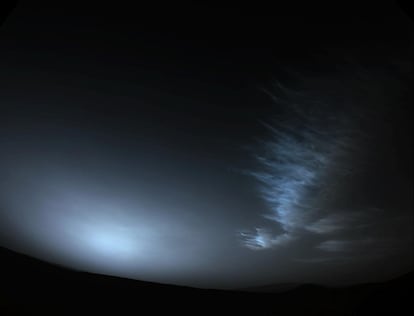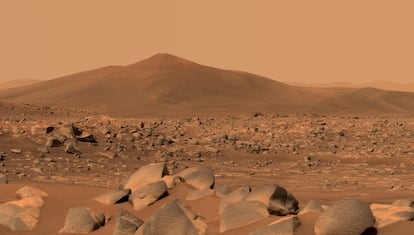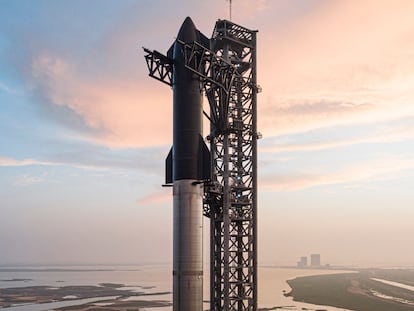The weather on Mars: Vast storms, strong winds, freezing temperatures and giant whirlwinds
With Spain at the helm, the MEDA program team has reconstructed the atmospheric behavior of the red planet over one Martian year

Knowing what the weather is going to be like is vital to help us plan our day-to-day lives or a special trip. If the latter is a trip to Mars with all the hopes and aspirations that come after years of research, it is critical to know as much as possible about the behavior of Mars’ thin atmosphere. Perseverance, NASA’s robot rover that has been roaming around the red planet since February 18, 2021, includes MEDA (Mars Environmental Dynamics Analyzer). Made up of a system of complex instruments designed by a team from seven countries led by the Spanish Astrobiology Center (CAB-CSIC-INTA), MEDA has already collected 2,500 images and more than 10,000 hours of data on pressure, temperature, wind, humidity, and the composition and behavior of the Martian atmosphere. The team, based at the Spanish Space Agency’s headquarters in Seville (Spain), has analysed the challenges and pitfalls of a mission that is fundamental to exploring the planet, as well as the information that shows what the weather on Mars is like.
Since landing one Martian year ago (equivalent to two Earth years), MEDA has not stopped working, even in winds of more than 62 miles per hour and storms capable of covering the entire surface of the planet. “We measure systematically. We permanently monitor all environmental parameters,” explains José Antonio Rodríguez Manfredi, principal researcher at MEDA and director of the Space Instrumentation Group at the Astrobiology Center.
The initial results were collected by Nature Geoscience last January. This month, researchers have updated the data obtained after hundreds of Martian sols (days) at the initiative of the Spanish Space Agency, the Institute of Microelectronics of Seville (US-CSIC joint center), and the National Institute of Aerospace Technology.
Dust. Rodríguez Manfredi explains that dust is “the main element in the atmospheric dynamics” of Mars, where a permanent, global cycle of suspended particles is recorded. And it is also one of MEDA’s challenges. “It ends up affecting our equipment, but we have mechanisms designed to mitigate its impact,” he explains. Special protectors and magnetic scanning mechanisms are two of them, as well as equipment redundancy to complete and correct faulty data that any particular sensor may return.
Cells. Spanish research has made it possible to observe global patterns of atmospheric circulation (cells) that determine the weather on Mars. Like on Earth, they are convective systems that circulate heat. The research also studies the local weather in the Jezero crater. The large basin that Perseverance is exploring was formed by the impact of a meteorite about 3.5 billion years ago that filled to form a huge lake with a river flowing from it. “These cells affect environmental parameters, in some aspects, more than global circulation,” says the researcher.
Studying the relationship between local and global micrometeorology is one of MEDA’s great achievements. “It provides high-precision meteorological measurements that have allowed us to characterize the Martian atmosphere from local scales at distances of a few meters, as well as on a global scale by collecting information about what is happening thousands of miles away. It has never been done before, and all of this will allow us to better understand the Martian climate and improve the predictive models we use,” says Agustín Sánchez-Lavega, professor at the Faculty of Engineering — Bilbao (EIB) and co-researcher of the Mars 2020 mission.
Extraterrestrial halos. The team led by Spain has also observed an extraterrestrial halo for the first time. The halos seen on Earth are caused by ice particles suspended in the troposphere refracting light and generating a spectrum of colors around the Sun or Moon. “A halo had never been seen on another planet and it has been tremendously interesting,” says Rodríguez Manfredi.

Clouds. Daniel Toledo, researcher on the MEDA instrument team in the Payloads Department of INTA, highlights in a CSIC note that the “discovery of the halo provides key information about the properties of clouds on Mars.” Despite the presence of ice and cloud movements, no precipitation as we understand it on Earth has ever been detected. “Although there is water, steam, and clouds, the conditions of low temperatures (about 50 degrees below zero [Celsius] in the Jezero area) and pressures (6.1 millibars on average compared to 1,013 on Earth) mean that it cannot precipitate as water. Being generous, these clouds can precipitate in the form of ice, but only under very specific conditions.”
Ice. This frozen water is not usable by future human settlements. It is easier to resort to subsoil ice. But not at the poles, where, according to the team’s lead researcher, the temperature conditions (up to –140 degrees Celsius) and radiation are so extreme that they make these areas uninhabitable. The refuge for humans in the future will be located on the the planet’s equator, where a summer maximum of between positive two and seven degrees Celsius can be reached. But any human exploration outside is limited, since the planet’s thin atmosphere (1% of the Earth’s) provides no protection from solar radiation.
Seasons. MEDA has observed four distinctly Martian seasons, similar to those on Earth. And in a similar way to the seasons on Earth, there are phenomena, such as storms, that feature in each of them. “It would be important to be able to predict them in future manned missions,” Rodríguez Manfredi explains. Predicting them will also be important with regard to landing a future mission to recover the samples collected by Perseverance.
Storms. Usually lasting up to seven days and accompanied by dust devils, storms can be both local and global, and can cover the entire planet for weeks. “Everything is covered as if by a veil of dust that then settles.” The effect is similar to the haze we can observe occasionally on Earth, caused by desert sand particles or smoke suspended in the air.
Wind. Gusts of 25 and 30 meters per second (about 62 miles per hour) have been recorded. But Mars brings a surprise regarding how gusts are felt. “If you were on Mars and you could take off your helmet to feel the wind on your face. Whereas on Earth, gusts of several miles per hour feel quite strong, on Mars they would fell like a gentle breeze. The atmosphere is very thin and the air is very thin. This means that, although the wind is very strong, the drag capacity is much lower,” explains Rodríguez Manfredi, who uses a terrestrial example to explain it: it is like moving your arm rapidly in the terrestrial air and in a swimming pool. Resistance is greater in water.

Pressure. Thedust in the Martian atmosphere is also key to determining atmospheric pressure. Rodríguez Manfredi explains: “If there is a lot of dust, when the sun heats it, it causes the temperature to change and that mass tends to rise, as if it were being pulled up.” It is one of the reasons for the whirlwinds, which can become gigantic. “Pressure and temperature follow the daily cycle of sunshine and are greatly influenced by the amount of dust and the presence of clouds in the atmosphere,” says Sánchez-Lavega.
Whirlwinds. “They are more abundant on Jezero than anywhere else on Mars and they can be very large, exceeding 100 meters in diameter. Through MEDA we have been able to characterize not only their general features (size and frequency) but also unravel how these vortices work,” says Ricardo Hueso, professor at the Bilbao School of Engineering (BEI) after publishing results of research in Nature Geoscience .
The Seville meeting has also served to analyze future strategy. MEDA is part of a complex exploration program that depends on Perseverance and associated devices. The key to the success of the mission is its survival until a vehicle collects the samples obtained so far. For this reason, the common strategy is to keep all devices safe and avoid scans that put them at risk. The Martian meteorological team’s strategy also has to work within this balance between anxiousness to explore, costs, and caution.
Sign up for our weekly newsletter to get more English-language news coverage from EL PAÍS USA Edition
Tu suscripción se está usando en otro dispositivo
¿Quieres añadir otro usuario a tu suscripción?
Si continúas leyendo en este dispositivo, no se podrá leer en el otro.
FlechaTu suscripción se está usando en otro dispositivo y solo puedes acceder a EL PAÍS desde un dispositivo a la vez.
Si quieres compartir tu cuenta, cambia tu suscripción a la modalidad Premium, así podrás añadir otro usuario. Cada uno accederá con su propia cuenta de email, lo que os permitirá personalizar vuestra experiencia en EL PAÍS.
¿Tienes una suscripción de empresa? Accede aquí para contratar más cuentas.
En el caso de no saber quién está usando tu cuenta, te recomendamos cambiar tu contraseña aquí.
Si decides continuar compartiendo tu cuenta, este mensaje se mostrará en tu dispositivo y en el de la otra persona que está usando tu cuenta de forma indefinida, afectando a tu experiencia de lectura. Puedes consultar aquí los términos y condiciones de la suscripción digital.
More information
Archived In
Últimas noticias
From digital curfews to blocking apps: How technology experts protect their children online
Why the price of coffee has skyrocketed: from Brazilian plantations to specialty coffee houses
Confined to a Cuban hospital: When electricity is a matter of life or death
How Japan is trying to avert ‘digital defeat’
Most viewed
- Pablo Escobar’s hippos: A serious environmental problem, 40 years on
- Reinhard Genzel, Nobel laureate in physics: ‘One-minute videos will never give you the truth’
- Why we lost the habit of sleeping in two segments and how that changed our sense of time
- Charles Dubouloz, mountaineering star, retires at 36 with a farewell tour inspired by Walter Bonatti
- The Florida Keys tourist paradise is besieged by immigration agents: ‘We’ve never seen anything like this’










































